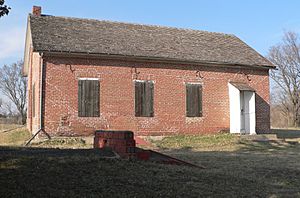List of ghost towns in Nebraska facts for kids
A ghost town is a place that used to be a town but is now mostly or completely empty. People leave ghost towns for many reasons. Sometimes, a mine closes, or a railroad moves away. Other times, natural disasters or changes in farming make people leave.
Nebraska has many ghost towns and places that are almost ghost towns. These places tell stories about the state's past and the people who lived there.

Contents
Exploring Nebraska's Ghost Towns
Nebraska's landscape is dotted with the remains of towns that once thrived. Each ghost town has its own unique story, often linked to the state's history of farming, railroads, or early settlements. Some towns completely disappeared, while others still have a few residents or old buildings left.
What Makes a Town a Ghost Town?
A town becomes a ghost town when most of its people move away. This can happen if the main reason the town existed, like a factory or a valuable resource, is no longer there. For example, a town built around a gold mine might become a ghost town when the gold runs out. In Nebraska, many towns grew because of farming or the railroad. If farming became difficult or the railroad line changed, people often left.
Notable Ghost Towns and Near Ghost Towns
Here are some interesting ghost towns and places in Nebraska that are almost ghost towns:
- Ames (Dodge County): This isn't a full ghost town! A few people still live here. It's a good example of a town that shrunk but didn't completely disappear.
- Andrews (Sioux County): This town was established in 1906 but was disestablished by 1951. It shows how quickly towns could appear and disappear in the early 20th century.
- Arago (Richardson County): Founded in 1860, some people believe Arago and another place called Fargo were separate communities. It's a mystery waiting to be solved!
- Ashford (Banner County): This town was once important enough to be the temporary county seat for Banner County in 1889. A county seat is where the local government is located.
- Brewster (Blaine County): Brewster is the county seat of Blaine County. It's not a full ghost town, with a small population of 17 people. Fun fact: A character named Finn Sawyer from the TV show Bunk'd is said to be from Brewster, Nebraska!
- Crouse (Lancaster County): This former town is now part of the beautiful Branched Oak State Recreation Area. It's a reminder that nature can reclaim old settlements.
- DeWitty (Cherry County): Also known as Audacious, this town has a unique history. It was a settlement where many African American homesteaders lived and built a community.
- Dobytown (Kearney County): This was an important stop along the Oregon Trail and Mormon Trail. It was known for its sod buildings, which were houses made from chunks of grass and soil.
- Dyson Hollow Lime Kiln (Sarpy County): This isn't a town, but it's a historic site. A lime kiln was used to heat limestone to make lime, which was important for building and farming.
- Eclipse (Hooker County): Established around 1913, this town has a special claim to fame: the first white person born in Hooker County was born here.
- Elvira (Merrick County): This town once held the important title of county seat for Merrick County.
- Factoryville (Cass County): Also known as Union Mills, this town likely had some kind of factory or mill that was central to its existence.
- Gross (Boyd County): This is considered a "near ghost town," meaning it's almost empty but might still have a few residents or buildings.
- Hope (Scotts Bluff County): This town was named "Hope" because people had great hopes for their community. It was a diverse place where Jewish, Black, and white people lived together.
- Monowi (Boyd County): This is perhaps Nebraska's most famous "near ghost town," with only one resident, Elsie Eiler, as of 2010! Monowi has even been featured in advertisements for big companies like Coca-Cola and Arby's. They even won a world record for the biggest advertisement sign ever made!
- Mud Springs (Morrill County): This was another important stop along the Oregon Trail and California Trail. It was a vital watering hole for travelers.
- Omadi (Dakota County): Founded in 1856, Omadi was one of the earlier settlements in Nebraska.
- Oreapolis (Cass County): This town existed for a short time, from 1859 to 1864. Its quick disappearance shows how some early settlements didn't last long.
- Rock Bluff (Cass County): This town has a historic school building, the Rock Bluff School, which was once the Naomi Institute. It's a reminder of the importance of education in early Nebraska towns.
These ghost towns are like time capsules, offering glimpses into Nebraska's past and the lives of the people who tried to build new homes and communities.
Images for kids


